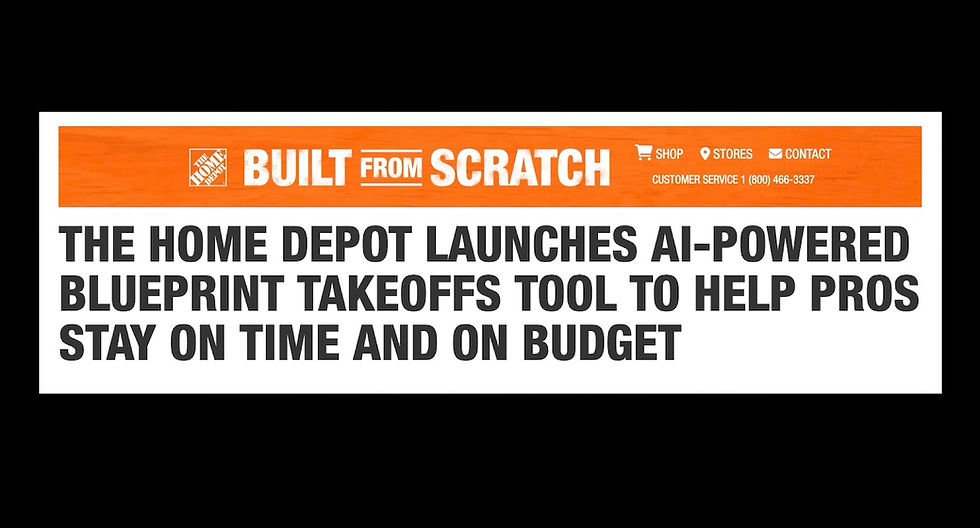Plan Now to Retool Your Business to Thrive Despite Stagflation
- Craig Webb

- Jul 7, 2022
- 7 min read

By Craig Webb
President, Webb Analytics
Running a lumberyard these days can feel like playing a video game. It’s been a chaotic, adrenaline-filled experience as you racked up sales—and profits—in a torrid housing market. But now, as in that video game, you’re entering a new level, one that features an enemy your company hasn’t encountered in decades and you probably never had to confront.
That enemy is stagflation. It’s an economic condition that combines a stagnant gross domestic product with high inflation. America hasn’t seen it since the 1970s and early 1980s, when an OPEC embargo sent gas prices quadrupling, the unemployment rate climbed to nearly 6%, and consumer prices rose 11% per year. It took a recession, Federal Reserve tightening, and a near doubling of the jobless rate to tame inflation. But the medicine worked. It set the stage for decades of low inflation, a modest jobless rate, and long-term economic growth.
Today we have COVID, the Ukraine war’s impact on oil prices, and too much stimulus money cited as the principal causes for our economic straits. Interest rates keep rising—the annual growth rate was 8.6% in May—and the Federal Reserve has begun raising benchmark lending rates. Treasury Secretary Janet Yellen predicts price increases likely will continue for months to come. The stock market has lost ground, and fears of a recession are increasing.
But an economic downturn generally doesn’t mandate that housing will suffer specifically. Odds are, housing won’t be hit as hard, if only because there’s so much pent-up demand. Several forecasts predict starts will decline by only a few percentage points in 2023—mainly in the starter and move-up sectors—and remodeling expenditures could grow in the 10% to 15% range between now and fall of next year. Meanwhile, product shortages for some products will continue at least through the rest of this year. For instance, springs for garage doors remain on allocation, and other garage parts still take 10-11 weeks to arrive now vs. 12-14 weeks earlier the year.
So, what should be your game plan if stagflation becomes a reality? Make these management moves.
Go Beyond Counting Today’s Dollars
If you haven’t begun already, start tracking products by number of units sold, because higher prices can mask decreased volumes. In the United Kingdom, the value of goods shipped appeared to be negligible in April—just a 0.9% decline from the same month last year. But sales changes were small because a 17% increase in the value of goods sold nearly overcame a 15.3% drop in volume sales. As commodity prices drop, that decline in volume is going to become ever more dangerous. Comparing units and dollars will help assure you’re achieving target gross margins for each product you put on the truck.
“[O]nly gains in purchasing power represent real earnings on investment.,” Warren Buffett—one of the few leaders surviving who managed a business in the last stagflation period—wrote in his 1980 letter to Berkshire Hathaway shareholders. “If you (a) forego 10 hamburgers to purchase an investment; (b) receive dividends which, after tax, buy two hamburgers; and (c) receive, upon sale of your holdings, after-tax proceeds that will buy eight hamburgers, then (d) you have had no real income from your investment, no matter how much it appreciated in dollars. You may feel richer, but you won’t eat richer.”
To help keep track of whether your hamburger count has gone up, begin indexing your real—I.e., inflation-adjusted—cash flow. If your sales dollars grew by 10% but the inflation rate is 7.5%, you’re only one-quarter better than you thought you were.
Curb Personnel Costs
A performance bonus is a one-time thing, but a pay raise lasts forever. Therefore, in lieu of pay raises, promote a culture in which everybody benefits when times are good but understands it’s their job to save some of those funds for when hard times come. That way, when sales drop, your personnel costs as a share of sales go down as well.
Consider outsourcing, too, especially if you have to deal with rises and falls in activity, or if you want to redeploy your forces. Outsourcing material takeoffs is one example: Firms like Paradigm can take on this work and thus leave time for your sales reps to pursue new customers—something they’ll need to resume as business slows. According to Webb Analytics’ 2022 Construction Supply 150 report on America’s biggest dealers, 46% of reporting companies said most takeoffs at their business was done by sales reps, 32% primarily used another staffer, and only 22% relied on an outside service.
“A lot of our lumberyard customers are relying on outsourcing takeoffs to navigate the peaks and valleys in the business,” notes Mohammad Zagnoon, Paradigm’s Director of Operations. “A takeoff service helps maintain lead times during peak season and allows the sales team to focus on what they do best. On the flip side, an outside service can stand down when the business is slower, so the LBM operation maintains staff continuity.”
In addition, working from home is coveted so much that many people will accept lower pay if they can operate that way rather than commute. For lots of your back-office staff needs, this could be a way to expand your candidates pool and pay less besides.
Focus on Efficiency—for Both You and Your Customers
Our go-go housing economy also has been a “Git-R-Done” economy, in which builders don’t care about prices and processes because they can sell every home they complete. “Ironically, you’ll find the most waste at the most successful companies,” writes Mark Mitchell, a building material sales consultant. “Because they can afford to be wasteful, they don’t make it a top priority.”
With demand so high and price concerns so comparatively low, dealers nationwide tell me it’s common for sales reps to spend half their time simply keeping customers up to date about product costs and availability. Nobody has the time or inclination to ask, “Can we build better and cheaper?”
Stagflation changes that scenario. Compared with what we’ve been through, the slight slowdown in construction’s pace will feel like a vacation to some builders, at last giving them time to think about the future. Meanwhile, if material prices rise faster than home prices do, builders will be open to suppliers’ ideas about how to improve. And they’ll become less tolerant to any dealer errors that cost them money.
“Wasted time and materials are profit killers regardless of the economy,” says Caleb Gieseke, Paradigm Estimate Practice Manager. “But accurate takeoffs and customized cut lists are especially critical in an inflationary period. Think about the cost benefits reducing unexpected deliveries or material pickups from job sites. We recently had a customer who was able to reduce the number of special deliveries to the jobsite from an average of six to one. And at the end of the job, there were only a handful of boards left.”
Cutting costs also brings a side benefit: It boosts the payback from serving a smaller customer. That makes it possible to widen your sales base—another Mitchell recommendation for getting through tougher times.
In addition, make sure your takeoff people are aware of what’s in stock. An alert takeoff team can suggest ways to use slow-moving lumber lengths in projects, thus removing potential losses from your inventory.
Having an independent expert involved also pays dividends if you face staffing challenges. Rookie sales reps and OSRs who are great at closing but are weak on advising both could benefit from having a wingman to provide backup.
Become Fanatical About Errors
It’s not just the dealer that suffers, if you believe Jim Enter’s 10X rule. The longtime LBM consultant estimates that the cost to the dealer of fixing a mistake jumps 10 times every step the error gets closer to the customer. Thus, a $1 error in which the wrong product is pulled eventually could escalate into a $1,000 error if that wrong product goes onto the house and has to be removed.
“The cost implications actually are worse … because you pay for that error out of your earnings,” Enter adds. “Assuming you have a pretax profit of 5%, a preventable $1,000 error requires a sale of $20,000 just to pay for the preventable problem. And this doesn’t include the ‘soft’ cost of late deliveries, overtime, or upset and possibly lost customers.”
We’re heading into a time in which sales reps and others at the lumberyard can become advisers, not just suppliers, to the construction community. Along with recommending products that are better suited to builders needs than what they’re using now, dealers also can suggest ways to tweak plans so that materials can be better utilized, thus reducing waste. They also can show how developments in framing and products can yield better-built homes at the same price or less.
“Lumberyards can lean on an outsourced takeoff service that uses technology to optimize material quantities, prevent waste, and ensure their builders get the most out of every board foot,” explains Gieseke. For instance, in places where lumber waste had amounted to 5% or 10% of the total delivery, Paradigm Estimate users have seen waste drop to just 3%. Likewise, “Dealers who are constantly dealing with special deliveries should examine the accuracy of their takeoffs and dial in the rules used to specify materials,” Gieseke adds.
Steer Clear of Debt … and Debtors
In March 2020, a bank might offer business lines of credit for roughly 5% per annum (a prime rate of 3.25% plus 1.75%). Thus, a line of credit loan of $1 million would rack up $27,300 in interest over the course of a year. Today that LOC may carry a 6.75% interest rate, and with continued inflation the charge could easily hit 10%. That doubles your borrowing costs to $55,000. Clearly, a high-interest environment is no time to be owing people.
At the same time, stagflation makes the dollar worth less every day, so watch your receivables so that you put your revenue to good use rather than wait for the check. Technology can help here. Systems that let people see their statement and then pay you online will put money into your account several days earlier than if you rely on mailers and checks. Encourage payment via bank transfer rather than by credit card. If the math works out, let somebody else take over the credit risk, either by managing your receivables or providing buy-now, pay-later services.
The last time stagflation happened in the U.S., economic management was a primitive science; we were only a few years past the end of the gold standard, Richard Nixon’s freezing of wages and prices, and Gerald Ford’s ill-fated “Whip Inflation Now” campaign. We’re much smarter now, with much better computers to help us. Even so, beating stagflation won’t be easy. This level of the game is going to be tough.
Craig Webb is president of Webb Analytics, a Washington-based consultancy that helps all parts of the construction supply chain spot trends, threats, and opportunities. www.webb-analytics.com. cwebb@webb-analytics.com






Comments